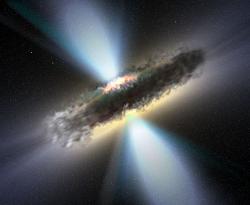 Although the centre of the Milky Way is obscured by gas and dust, you can see right through using wavelengths other than the visible spectrum. Infrared is great, but it can also be revealed in gamma rays. And here’s the strange thing, gamma rays are pouring out from the centre of our galaxy.
Although the centre of the Milky Way is obscured by gas and dust, you can see right through using wavelengths other than the visible spectrum. Infrared is great, but it can also be revealed in gamma rays. And here’s the strange thing, gamma rays are pouring out from the centre of our galaxy.
Continue reading “Our Supermassive Black Hole Is a Natural Particle Accelerator”
What’s Up this Week: February 26 – March 4, 2007
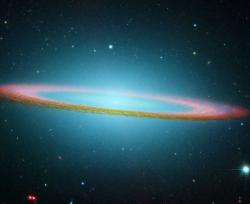 Monday, February 26 – Today is the birthdate of Camille Flammarion. Born in 1842, he became a widely read author in astronomy and conceived the idea that we were not alone – the idea of extraterrestrial life. Yet, Flammarion was just a little bit more than the great-grandfather of SETI. In 1877, Flammarion had an unusual chance that most of us only dream of. He had his hands on a personal copy and notes of the Messier Catalog. Using it as a reference, he later revised it, but his studies led him to identify M102 with NGC 5866 before 1917. By 1921, Flammarion had added M104 – now known as NGC 4594 – to the catalog as well, and it became the first of many additions.
Monday, February 26 – Today is the birthdate of Camille Flammarion. Born in 1842, he became a widely read author in astronomy and conceived the idea that we were not alone – the idea of extraterrestrial life. Yet, Flammarion was just a little bit more than the great-grandfather of SETI. In 1877, Flammarion had an unusual chance that most of us only dream of. He had his hands on a personal copy and notes of the Messier Catalog. Using it as a reference, he later revised it, but his studies led him to identify M102 with NGC 5866 before 1917. By 1921, Flammarion had added M104 – now known as NGC 4594 – to the catalog as well, and it became the first of many additions.
Continue reading “What’s Up this Week: February 26 – March 4, 2007”
Rosetta Gets an Amazing View as it Skims Past Mars
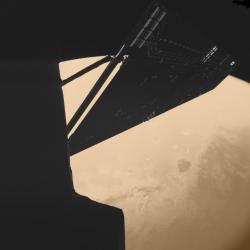 This absolutely stunning photograph was taken by ESA’s Rosetta spacecraft during its recent flyby past Mars on Saturday. In order to receive a gravity boost from the planet, the spacecraft flew past only 1,000 km above the surface.
This absolutely stunning photograph was taken by ESA’s Rosetta spacecraft during its recent flyby past Mars on Saturday. In order to receive a gravity boost from the planet, the spacecraft flew past only 1,000 km above the surface.
Continue reading “Rosetta Gets an Amazing View as it Skims Past Mars”
A Baby Picture of the Sun
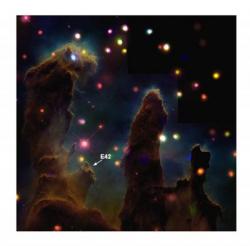 Obviously there’s no way to see what our Sun looked like when it was still forming billions of years ago, but you can do the next best thing. Find a newly forming star with very similar mass and chemical constituents, and see how it’s starting out.
Obviously there’s no way to see what our Sun looked like when it was still forming billions of years ago, but you can do the next best thing. Find a newly forming star with very similar mass and chemical constituents, and see how it’s starting out.
Continue reading “A Baby Picture of the Sun”
Some Galaxies Are Made Almost Entirely of Dark Matter
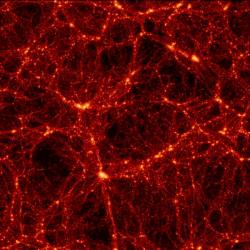 When we think of a galaxy, we think of our own Milky Way or perhaps Andromeda; a majestic spiral containing hundreds of billions of stars. Or maybe we think of an irregular galaxy, not so majestic-looking, but still made of regular stuff, like stars, planets… people.
When we think of a galaxy, we think of our own Milky Way or perhaps Andromeda; a majestic spiral containing hundreds of billions of stars. Or maybe we think of an irregular galaxy, not so majestic-looking, but still made of regular stuff, like stars, planets… people.
Continue reading “Some Galaxies Are Made Almost Entirely of Dark Matter”
Ulysses Sees a Surprise at the Sun’s South Pole
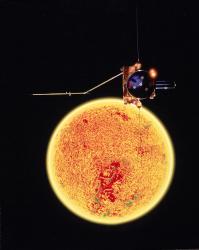 Our Sun is very close to the calmest point of its 11-year cycle of activity, what scientists call the “Solar Minimum”. But that doesn’t mean it’s totally quiet. In mid-December, NASA/ESA’s Ulysses spacecraft encountered a torrent of particles bursting from the Sun’s southern pole.
Our Sun is very close to the calmest point of its 11-year cycle of activity, what scientists call the “Solar Minimum”. But that doesn’t mean it’s totally quiet. In mid-December, NASA/ESA’s Ulysses spacecraft encountered a torrent of particles bursting from the Sun’s southern pole.
Continue reading “Ulysses Sees a Surprise at the Sun’s South Pole”
The Mighty Mississippi, from Space
 Here’s a beautiful photograph of the Mississippi River Delta taken by ESA’s Envisat Earth observation satellite. The image shows how the river empties sediment into the Gulf of Mexico, slowly building up the jutting peninsula. Natural and man-made factors have reversed this process over the last century, though, and Louisiana is losing its protective wetlands. The city of New Orleans is visible as the white crescent just below the inland Lake Pontchartrain.
Here’s a beautiful photograph of the Mississippi River Delta taken by ESA’s Envisat Earth observation satellite. The image shows how the river empties sediment into the Gulf of Mexico, slowly building up the jutting peninsula. Natural and man-made factors have reversed this process over the last century, though, and Louisiana is losing its protective wetlands. The city of New Orleans is visible as the white crescent just below the inland Lake Pontchartrain.
Continue reading “The Mighty Mississippi, from Space”
XMM-Newton’s View of Supernova 1987A
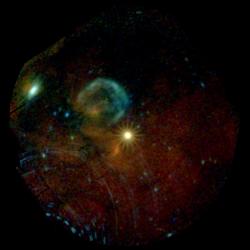 I linked you to an image of Supernova 1987A taken by the Hubble Space Telescope around the explosion’s 20th anniversary. Here’s another, this time taken by ESA’s XMM-Newton Observatory to show you how it looks in X-rays.
I linked you to an image of Supernova 1987A taken by the Hubble Space Telescope around the explosion’s 20th anniversary. Here’s another, this time taken by ESA’s XMM-Newton Observatory to show you how it looks in X-rays.
Continue reading “XMM-Newton’s View of Supernova 1987A”
Scientists Lobbying to Search for Life on Europa
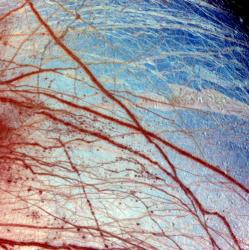 Recently I reported on a proposal that spacecraft should return to Jupiter’s moon Europa to determine if it really has an ocean under its icy shell. Another group of scientists are lobbying for a return to Europa as well, as they feel it’s one of the most likely places to find other life in the Solar System.
Recently I reported on a proposal that spacecraft should return to Jupiter’s moon Europa to determine if it really has an ocean under its icy shell. Another group of scientists are lobbying for a return to Europa as well, as they feel it’s one of the most likely places to find other life in the Solar System.
Continue reading “Scientists Lobbying to Search for Life on Europa”
Star’s Magnetic Field Slams its Solar Winds Back Together
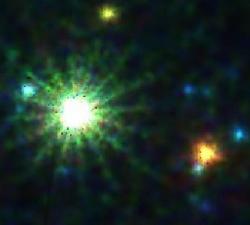 ESA’s XMM-Newton X-Ray observatory has helped astronomers puzzle through a mystery that’s haunted them for a long time. For more than 20 years, observatories have detected X-rays streaming from something in the AB Aurigae system. But nothing in the system should be able to generate this quantity of X-rays.
ESA’s XMM-Newton X-Ray observatory has helped astronomers puzzle through a mystery that’s haunted them for a long time. For more than 20 years, observatories have detected X-rays streaming from something in the AB Aurigae system. But nothing in the system should be able to generate this quantity of X-rays.
Continue reading “Star’s Magnetic Field Slams its Solar Winds Back Together”
